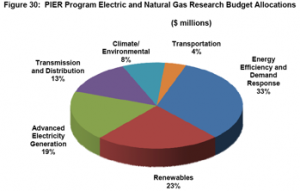From the Center for Sustainable Energy, California (5/11/2010) –
Unlike California’s stringent Title 24 building energy efficiency codes that regulate standards for commercial construction and renovations, AB 1103 comes into play when a building is sold, leased in whole or refinanced. Along with the usual financial and transaction disclosures, it requires that building owners provide 12 months of energy-use information using the U.S. Environmental Protection Agency’s (EPA) ENERGY STAR Portfolio Manager,.
AB 1103 is one of the ways the state legislature is working to help achieve the greenhouse gas emission reductions mandated by the California Global Warming Solutions Act of 2006, also known as AB 32. Commercial buildings account for more than 35 percent of electricity consumption in California and are significant contributors to the state’s greenhouse gas emissions.
While many in the commercial real estate marketplace believe AB 1103 regulations will be a big headache, they should really see this energy benchmarking as a tremendous opportunity that can benefit both sellers and buyers, according to Beth Brummitt, president of Brummitt Energy Associates, a consulting firm specializing in energy modeling for high-performance buildings. Brummitt was among a panel of local green-building experts who spoke at CCSE in April as part of a workshop on AB 1103 and its impacts on commercial real estate transactions.
“ AB 1103 is a significant game changer across California because it demands a true comparison of building performance with other, similar facilities within the same industry sector, not simply a disclosure of monthly utility costs and energy consumption,” Brummitt said. “Even though building owners may think this is going to harm them, it will actually provide motivation to improve building energy performance, resulting in increased net operating income and enhanced property values.”
The ENERGY STAR Portfolio Manager is a free, online software tool that allows users to track and assess energy consumption tailored to the occupancy of the building in 13 broad categories from banking to warehousing.
“It makes comparisons of a building’s energy performance to statistically representative models of equivalent buildings with similar operating characteristics drawn from a national database compiled by the Department of Energy’s Energy Information Administration,” explained Eric Scheidlinger, manager of efficient sustainable practices at Reno Construction.
In addition to 12 months’ worth of energy-use data and building use, the Portfolio Manager asks for the building size, number of occupants, hours of operation, number of computers, types of equipment and other parameters. In many areas, the local electrical utility can automatically supply and update energy consumption data on a monthly basis.
The result is a rating on a scale of one to 100. A rating of 50% means that the building performs at the midpoint when compared to similar buildings. While a building in Detroit will always use more energy than a comparable one in San Diego, the Portfolio Manager uses national weather data to assure that buildings are compared to those in similar climates. A building that achieves a verified score of 75 or above qualifies for ENERGY STAR certification.
The purpose of AB 1103, according to Brummitt, is to drive the commercial building owners to not only to track and but to also improve their ENERGY STAR rating by optimizing the energy performance of existing systems and installing new energy-efficient upgrades and renewable energy technologies. A higher rating means lower energy costs, decreased occupancy costs and, potentially, increased building valuation.
Buildings with ENERGY STAR certification generally use about 35 percent less energy and save, on average, 50 cents per square foot in energy costs, according to Steve Kaplan of McParlane Building Optimization, a mechanical engineering firm. A study published by the Institute of Business and Economic Research at UC Berkeley found that office buildings with energy efficiency certification have rental rates that are two percent higher per square foot than otherwise identical buildings nearby, and when adjusted for their higher occupancy levels, the “green premium” goes to above six percent.
Knowledgeable building owners and facility managers can usually handle the inputs for the ENERGY STAR Portfolio Manager, particularly if the local utility updates the monthly consumption data. However, since small mistakes can result in skewed information, owners should consider getting professional assistance. Energy Star provides both a benchmarking tool and has a program for awarding an ENERGY STAR Certification. To gain the certification, the data must be verified by a licensed professional engineer.
Commercial building owners in California should start compiling energy-use data this year, regardless of their intention to sell or hold onto their property. It may be a little complicated at first, but you never know when circumstances might require a quick sale, a new lease or a refinance. Starting now will be ever so much easier than trying to backtrack through a years’ worth of energy bills or being surprised by finding out building performance is lower than expected.
Related resources – Clean Techies Blog



 Despite the general weakness in new construction due to the global recession, one building-related field has continued to grow: retrofits tied to improving the efficiency of facilities. A number of factors have been driving this growth. In the new construction that has been taking place, these same drivers have been influencing the design of the buildings.
Despite the general weakness in new construction due to the global recession, one building-related field has continued to grow: retrofits tied to improving the efficiency of facilities. A number of factors have been driving this growth. In the new construction that has been taking place, these same drivers have been influencing the design of the buildings.